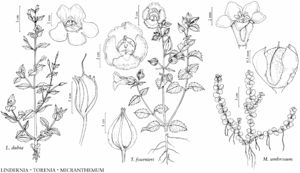Lindernia
Mélanges Philos. Math. Soc. Roy. Turin 3: 178, plate 5, fig. 1. 1766.
| Taxon | Illustrator ⠉ | |
|---|---|---|
 | Lindernia dubia Torenia fournieri Micranthemum umbrosum | Yevonn Wilson-Ramsey Yevonn Wilson-Ramsey Yevonn Wilson-Ramsey |
Annuals or perennials. Stems erect to prostrate, glabrous or sparsely stipitate-glandular. Leaves cauline, or basal and cauline, opposite; petiole present or absent; blade leathery or not, margins entire, remotely toothed, undulate, serrate, or serrulate. Inflorescences terminal, racemelike; bracts present. Flowers: sepals 5, ± connate, calyx radially to bilaterally symmetric, campanulate, not winged, lobes narrowly lanceolate or elliptic to triangular-ovate; petals 5, corolla white or purplish or bluish with darker purple, violet, or blue markings, bilaterally symmetric, bilabiate, cylindric, tube 0.3–10 mm, abaxial lobes 3, adaxial 1, emarginate to entire [2-lobed], forming a projecting adaxial lip; stamens 2 or 4, didynamous when 4, abaxial filaments 0 if stamens 2, papillate proximally, glabrous distally, appendage present, adaxial filaments glabrous, appendage absent; staminodes 0 or 2, geniculate, papillate proximally, glabrous distally, appendage present or absent. Capsules: dehiscence septicidal. Seeds 150–600, yellowish gold to reddish gold, cylindric, ellipsoid, oblong, ovoid, or irregularly angled. x = 7, 8, 9.
Distribution
North America, Mexico, West Indies, Central America, South America, Europe, Asia, Africa, Pacific Islands, Australia, tropical and temperate worldwide
Discussion
Species 30 or ca. 100 (6 in the flora).
F. W. Pennell (1935) merged Bonnaya, Ilysanthes, and Vandellia with Lindernia, and most subsequent authors have followed this broad generic concept, including about 100 species, with sections being used to account for the breadth of variation within the genus; for example, D. Q. Lewis (2000) recognized three sections for the North American species. Molecular studies led E. Fischer et al. (2013) to conclude that Lindernia as it has been treated is paraphyletic, and they proposed a new phylogeny of Linderniaceae. In their concept, Lindernia would include 30 species. In particular, this impacts the North American species as follows: L. antipoda = B. antipoda, L. ciliata = B. ciliata, and L. crustacea = Torenia crustacea.
Lindernia procumbens (Krocker) Borbás has been reported from North America [F. W. Pennell (1935) as L. pyxidaria Linnaeus; http://plants.usda.gov; and elsewhere] based on specimens that resemble this European species. These reports should be referred to L. dubia, since the specimens examined have the two fertile stamens of L. dubia instead of the four of L. procumbens. Lindernia diffusa (Linnaeus) Wettstein has been reported from South Carolina (http://plants.usda.gov) and Texas (P. J. Mahan, http://www.oldthingsforgotten.com/bearcreekpark/bearcreekpark.htm). The South Carolina report is based on a specimen of L. dubia that had been mislabeled in annotation, and the one from Texas on a misidentification of L. crustacea.
Selected References
Lower Taxa
Key
| 1 | Stamens 4; sepals connate 1/2–3/4 lengths. | Lindernia crustacea |
| 1 | Stamens 2; sepals connate to 1/4 lengths. | > 2 |
| 2 | Capsules narrowly lanceoloid to narrowly ellipsoid or cylindric; staminodes without appendages and distal segments. | > 3 |
| 3 | Leaf blade margins shallowly serrate to subentire. | Lindernia antipoda |
| 3 | Leaf blade margins sharply aristate-serrate. | Lindernia ciliata |
| 2 | Capsules ellipsoid, ovoid, or subglobular; staminodes with appendages and distal segments. | > 4 |
| 4 | Stems repent or prostrate, matted; distal leaves well developed or slightly reduced; leaf blades orbiculate, widely elliptic, or widely ovate. | Lindernia grandiflora |
| 4 | Stems erect, ascending, or prostrate, not matted; distal leaves well developed or much reduced; leaf blades spatulate, oblanceolate, obovate, elliptic, ovate, lanceolate, or linear-subulate. | > 5 |
| 5 | Perennials; leaves basal and cauline or, rarely, basal leaves absent, thick, leathery. | Lindernia monticola |
| 5 | Annuals; leaves cauline, thin, not leathery. | Lindernia dubia |